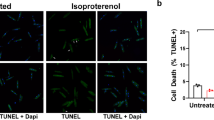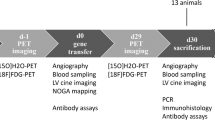Abstract
Targeting therapeutic gene expression to the skeletal muscle following intravenous (IV) administration is an attractive strategy for treating peripheral arterial disease (PAD), except that vector access to the ischemic limb could be a limiting factor. As adeno-associated virus serotype 9 (AAV-9) transduces skeletal muscle at high efficiency following systemic delivery, we employed AAV-9 vectors bearing luciferase or enhanced green fluorescent protein (eGFP) reporter genes to test the hypothesis that increased desialylation of cell-surface glycans secondary to hindlimb ischemia (HLI) might help offset the reduction in tissue perfusion that occurs in mouse models of PAD. The utility of the creatine kinase-based (CK6) promoter for restricting gene expression to the skeletal muscle was also examined by comparing it with the cytomegalovirus (CMV) promoter after systemic administration following surgically induced HLI. Despite reduced blood flow to the ischemic limbs, CK6 promoter-driven luciferase activities in the ischemic gastrocnemius (GA) muscles were ∼34-, ∼28- and ∼150-fold higher than in the fully perfused contralateral GA, heart and liver, respectively, 10 days after IV administration. Furthermore, luciferase activity from the CK6 promoter in the ischemic GA muscles was ∼twofold higher than with CMV, while in the liver CK6-driven activity was ∼42-fold lower than with CMV, demonstrating that the specificity of ischemic skeletal muscle transduction can be further improved with the muscle-specific promoters. Studies with Evans blue dye and fluorescently labeled lectins revealed that vascular permeability and desialylation of the cell-surface glycans were increased in the ischemic hindlimbs. Furthermore, AAV9/CK6/Luc vector genome copy numbers were ∼sixfold higher in the ischemic muscle compared with the non-ischemic muscle in the HLI model, whereas this trend was reversed when the same genome was packaged in the AAV-1 capsid (which binds sialylated, as opposed to desialylated glycans), further underscoring the importance of desialylation in the ischemic enhancement of transduction displayed by AAV-9. Taken together, these findings suggest two complementary mechanisms contributing to the preferential transduction of ischemic muscle by AAV-9: increased vascular permeability and desialylation. In conclusion, ischemic muscle is preferentially targeted following systemic administration of AAV-9 in a mouse model of HLI. Unmasking of the primary AAV-9 receptor as a result of ischemia may contribute importantly to this effect.
This is a preview of subscription content, access via your institution
Access options
Subscribe to this journal
Receive 12 print issues and online access
$259.00 per year
only $21.58 per issue
Buy this article
- Purchase on Springer Link
- Instant access to full article PDF
Prices may be subject to local taxes which are calculated during checkout





Similar content being viewed by others
References
Hirsch AT, Criqui MH, Treat-Jacobson D, Regensteiner JG, Creager MA, Olin JW et al. Peripheral arterial disease detection, awareness, and treatment in primary care. JAMA 2001; 286: 1317–1324.
Norgren L, Hiatt WR, Dormandy JA, Nehler MR, Harris KA, Fowkes FG et al. Inter-society consensus for the management of peripheral arterial disease (TASC II). Eur J Vasc Endovasc Surg 2007; 33 (Suppl 1): S1–S75.
Tongers J, Roncalli JG, Losordo DW . Therapeutic angiogenesis for critical limb ischemia: microvascular terapies coming of age. Circulation 2008; 118: 9–16.
Jones WS, Annex BH . Growth factors for therapeutic angiogenesis in peripheral arterial disease. Curr Opin Cardiol 2007; 22: 458–463.
Ghosh R, Walsh SR, Tang TY, Noorani A, Hayes PD . Gene therapy as a novel therapeutic option in the treatment of peripheral vascular disease: systematic review and meta-analysis. Int J Clin Pract 2008; 62: 1383–1390.
Snyder RO, Miao CH, Patijn GA, Spratt SK, Danos O, Nagy D et al. Persistent and therapeutic concentrations of human factor IX in mice after hepatic gene transfer of recombinant AAV vectors. Nat Genet 1997; 16: 270–276.
Flotte TR, Afione SA, Conrad C, McGrath SA, Solow R, Oka H et al. Stable in vivo expression of the cystic fibrosis transmembrane conductance regulator with an adeno-associated virus vector. Proc Natl Acad Sci USA 1993; 90: 10613–10617.
Hernandez YJ, Wang J, Kearns WG, Loiler S, Poirier A, Flotte TR . Latent adeno-associated virus infection elicits humoral but not cell-mediated immune responses in a nonhuman primate model. J Virol 1999; 73: 8549–8558.
Inagaki K, Fuess S, Storm TA, Gibson GA, McTiernan CF, Kay MA et al. Robust systemic transduction with AAV9 vectors in mice: efficient global cardiac gene transfer superior to that of AAV8. Mol Ther 2006; 14: 45–53.
Bostick B, Ghosh A, Yue Y, Long C, Duan D . Systemic AAV-9 transduction in mice is influenced by animal age but not by the route of administration. Gene Therapy 2007; 14: 1605–1609.
Reynolds PN, Nicklin SA, Kaliberova L, Boatman BG, Grizzle WE, Balyasnikova IV et al. Combined transductional and transcriptional targeting improves the specificity of transgene expression in vivo. Nat Biotech 2001; 19: 838–842.
Hauser MA, Robinson A, Hartigan-O'Connor D, Williams-Gregory DA, Buskin JN, Apone S et al. Analysis of muscle creatine kinase regulatory elements in recombinant adenoviral vectors. Mol Ther 2000; 2: 16–25.
Gregorevic P, Blankinship MJ, Allen JM, Crawford RW, Meuse L, Miller DG et al. Systemic delivery of genes to striated muscles using adeno-associated viral vectors. Nat Med 2004; 10: 828–834.
Salva MZ, Himeda CL, Tai PWL, Nishiuchi E, Gregorevic P, Allen JM et al. Design of tissue-specific regulatory cassettes for high-level rAAV-mediated expression in skeletal and cardiac muscle. Mol Ther 2007; 15: 320–329.
Wang B, Li J, Fu FH, Chen C, Zhu X, Zhou L et al. Construction and analysis of compact muscle-specific promoters for AAV vectors. Gene Therapy 2008; 15: 1489–1499.
Shen S, Bryant KD, Brown SM, Randell SH, Asokan A . Terminal N-linked galactose is the primary receptor for adeno-associated virus 9. J Biol Chem 2011; 286: 13532–13540.
Dokun AO, Keum S, Hazarika S, Li Y, Lamonte GM, Wheeler F et al. A quantitative trait locus (LSq-1) on mouse chromosome 7 is linked to the absence of tissue loss after surgical hindlimb ischemia. Circulation 2008; 117: 1207–1215.
Hazarika S, Dokun AO, Li Y, Popel AS, Kontos CD, Annex BH . Impaired angiogenesis after hindlimb ischemia in type 2 diabetes mellitus: differential regulation of vascular endothelial growth factor receptor 1 and soluble vascular endothelial growth factor receptor 1. Circ Res 2007; 101: 948–956.
Li Y, Hazarika S, Xie D, Pippen AM, Kontos CD, Annex BH . In mice with type 2 diabetes, a vascular endothelial growth factor (VEGF)-activating transcription factor modulates VEGF signaling and induces therapeutic angiogenesis after hindlimb ischemia. Diabetes 2007; 56: 656–665.
Creager MA, Olin JW, Belch JJF, Moneta GL, Henry TD, Rajagopalan S et al. Effect of hypoxia-inducible factor-1 gene therapy on walking performance in patients with intermittent claudication. Circulation 2011; 124: 1765–1773.
Rajagopalan S, Mohler ER, Lederman RJ, Mendelsohn FO, Saucedo JF, Goldman CK et al. Regional angiogenesis with vascular endothelial growth factor in peripheral arterial disease: a phase II randomized, double-blind, controlled study of adenoviral delivery of vascular endothelial growth factor 121 in patients with disabling intermittent claudication. Circulation 2003; 108: 1933–1938.
Baumgartner I, Chronos N, Comerota A, Henry T, Pasquet J-P, Finiels F et al. Local gene transfer and expression following intramuscular administration of FGF-1 plasmid DNA in patients with critical limb ischemia. Mol Ther 2009; 17: 914–921.
Byun J, Heard JM, Huh JE, Park SJ, Jung EA, Jeong JO et al. Efficient expression of the vascular endothelial growth factor gene in vitro and in vivo, using an adeno-associated virus vector. J Mol Cell Cardiol 2001; 33: 295–305.
Pinkenburg O, Pfosser A, Hinkel R, Bottcher M, Dinges C, Lebherz C et al. Recombinant adeno-associated virus-based gene transfer of cathelicidin induces therapeutic neovascularization preferentially via potent collateral growth. Hum Gene Ther 2009; 20: 159–167.
Makinen K, Manninen H, Hedman M, Matsi P, Mussalo H, Alhava E et al. Increased vascularity detected by digital subtraction angiography after VEGF gene transfer to human lower limb artery: a randomized, placebo-controlled, double-blinded phase II study. Mol Ther 2002; 6: 127–133.
Dong J-Y, Fan P-D, Frizzell RA . Quantitative analysis of the packaging capacity of recombinant adeno-associated virus. Human Gene Ther 1996; 7: 2101–2112.
Grieger JC, Samulski RJ . Packaging capacity of adeno-associated virus srotypes: impact of larger genomes on infectivity and postentry steps. J Virol 2005; 79: 9933–9944.
Rodino-Klapac LR, Janssen PML, Montgomery CL, Coley BD, Chicoine LG, Clark KR et al. A translational approach for limb vascular delivery of the micro-dystrophin gene without high volume or high pressure for treatment of Duchenne muscular dystrophy. J Trans Med 2007; 5: 45.
Arruda VR, Fields PA, Milner R, Wainwright L, De Miguel MP, Donovan PJ et al. Lack of germline transmission of vector sequences following systemic administration of recombinant AAV-2 vector in males. Mol Ther 2001; 4: 586–592.
Herzog RW, Fields PA, Arruda VR, Brubaker JO, Armstrong E, McClintock D et al. Influence of vector dose on factor IX-specific T and B cell responses in muscle-directed gene therapy. Hum Gene Ther 2002; 13: 1281–1291.
Ziv K, Nevo N, Dafni H, Israely T, Granot D, Brenner O et al. Longitudinal MRI tracking of the angiogenic response to hind limb ischemic injury in the mouse. Magn Reson Med 2004; 51: 304–311.
Moulay G, Scherman D, Kichler A . Fasting increases the in vivo gene delivery of AAV vectors. Clin Transl Sci 2010; 3: 333–336.
Prasad K-MR, Xu Y, Yang Z, Acton S, French BA . Robust cardiomyocyte-specific gene expression following systemic injection of AAV: in vivo gene delivery follows a Poisson distribution. Gene Therapy 2010; 18: 43–52.
Ried MU, Girod A, Leike K, Buning H, Hallek M . Adeno-associated virus capsids displaying immunoglobulin-binding domains permit antibody-mediated vector retargeting to specific cell surface receptors. J Virol 2002; 76: 4559–4566.
Prasad K-MR, Xu Y, Yang Z, Toufektsian M-C, Berr SS, French BA . Topoisomerase inhibition accelerates gene expression after adeno-associated virus-mediated gene transfer to the mammalian heart. Mol Ther 2007; 15: 764–771.
Wu JC, Inubushi M, Sundaresan G, Schelbert HR, Gambhir SS . Optical imaging of cardiac reporter gene expression in living rats. Circulation 2002; 105: 1631–1634.
Böhmer MR, Chlon CHT, Raju BI, Chin CT, Shevchenko T, Klibanov AL . Focused ultrasound and microbubbles for enhanced extravasation. J Control Release 148: 18–24.
Acknowledgements
We are grateful to Rebecca A. Maddux, Jane V. Carrick, Rachel E. Sullivan and John Burns for their valuable technical assistance and to Dr S D Hauschka for the plasmid construct bearing the 571bp CK6 enhancer/promoter fragment. SH acknowledges support from 5 T32 HL007284-35 and ABK from T32 HL073555. This work was supported, in part, by the NHLBI Gene Therapy Resource Program, and by grants from the American Heart Association (12GRNT12040223 to BAF) and the National Institutes of Health (NIH R01 HL058582 to BAF and NIH R01 HL101200 to BHA).
Author information
Authors and Affiliations
Corresponding author
Ethics declarations
Competing interests
The authors declare no conflict of interest.
Rights and permissions
About this article
Cite this article
Katwal, A., Konkalmatt, P., Piras, B. et al. Adeno-associated virus serotype 9 efficiently targets ischemic skeletal muscle following systemic delivery. Gene Ther 20, 930–938 (2013). https://doi.org/10.1038/gt.2013.16
Received:
Revised:
Accepted:
Published:
Issue Date:
DOI: https://doi.org/10.1038/gt.2013.16
Keywords
This article is cited by
-
Sildenafil increases AAV9 transduction after a systemic administration and enhances AAV9-dystrophin therapeutic effect in mdx mice
Gene Therapy (2024)
-
DOK7 Promotes NMJ Regeneration After Nerve Injury
Molecular Neurobiology (2023)
-
Sirt6 reprograms myofibers to oxidative type through CREB-dependent Sox6 suppression
Nature Communications (2022)
-
Mitochondrial targeted meganuclease as a platform to eliminate mutant mtDNA in vivo
Nature Communications (2021)
-
Rapid, scalable, and low-cost purification of recombinant adeno-associated virus produced by baculovirus expression vector system
Molecular Therapy - Methods & Clinical Development (2016)



